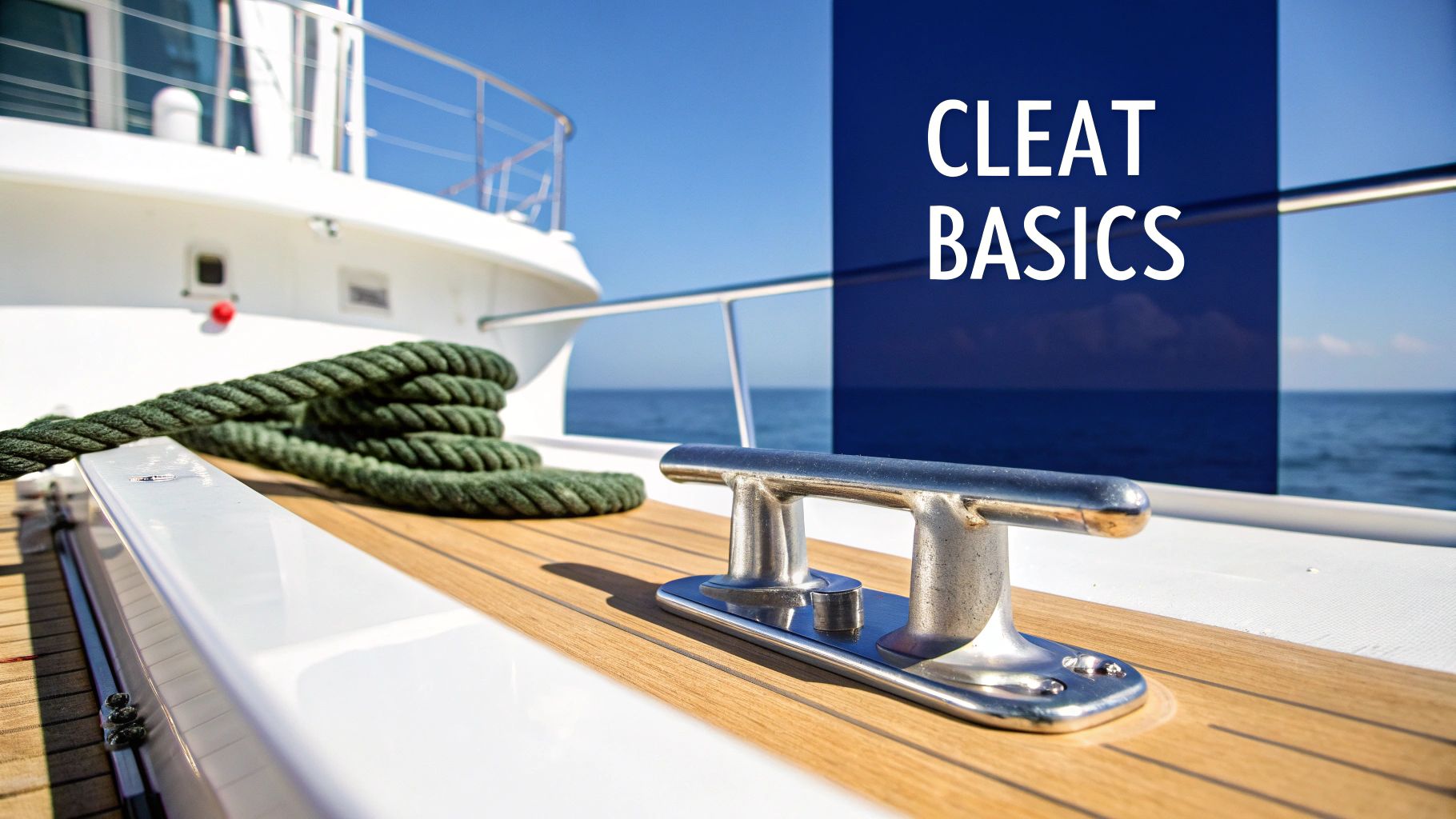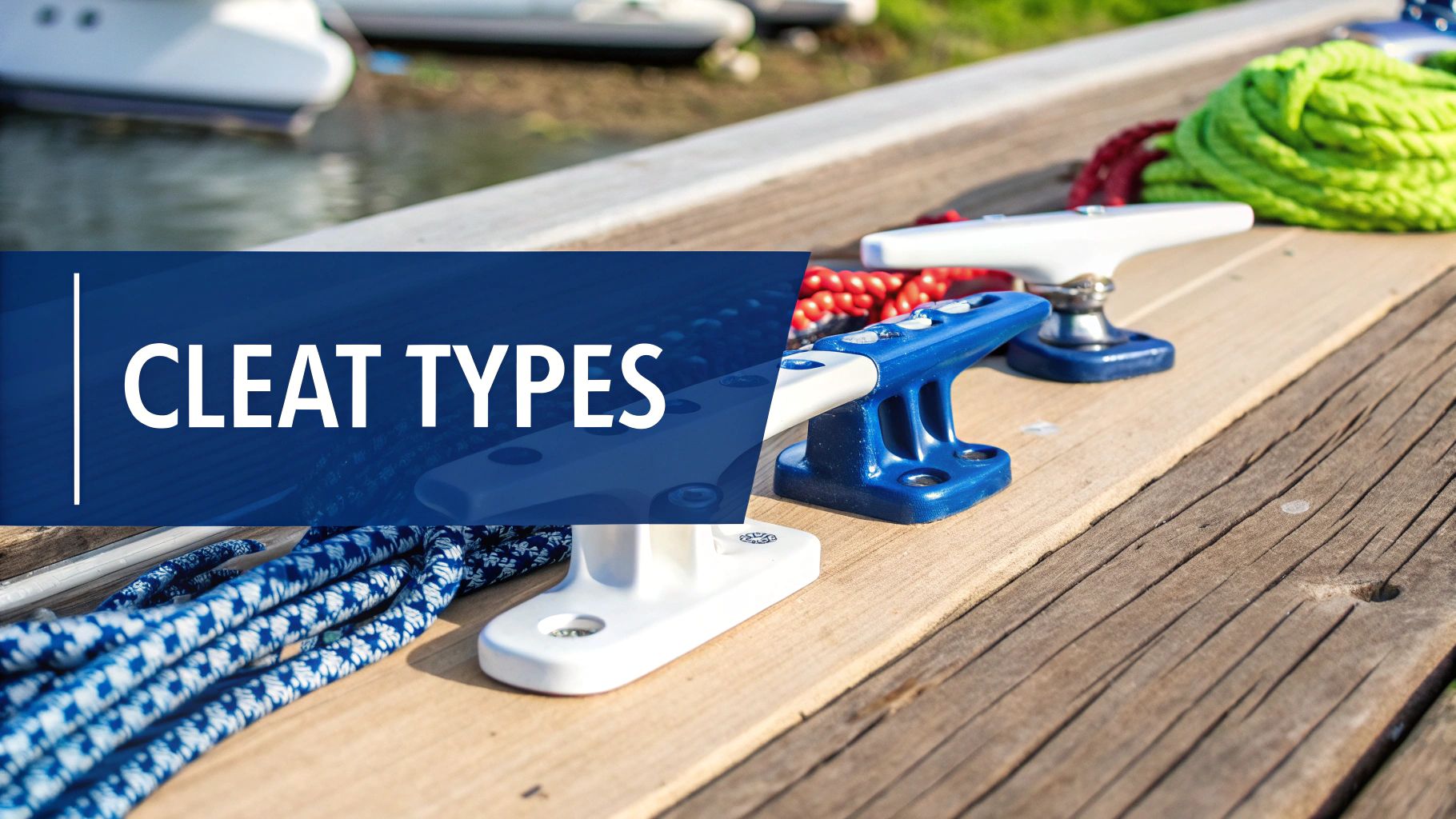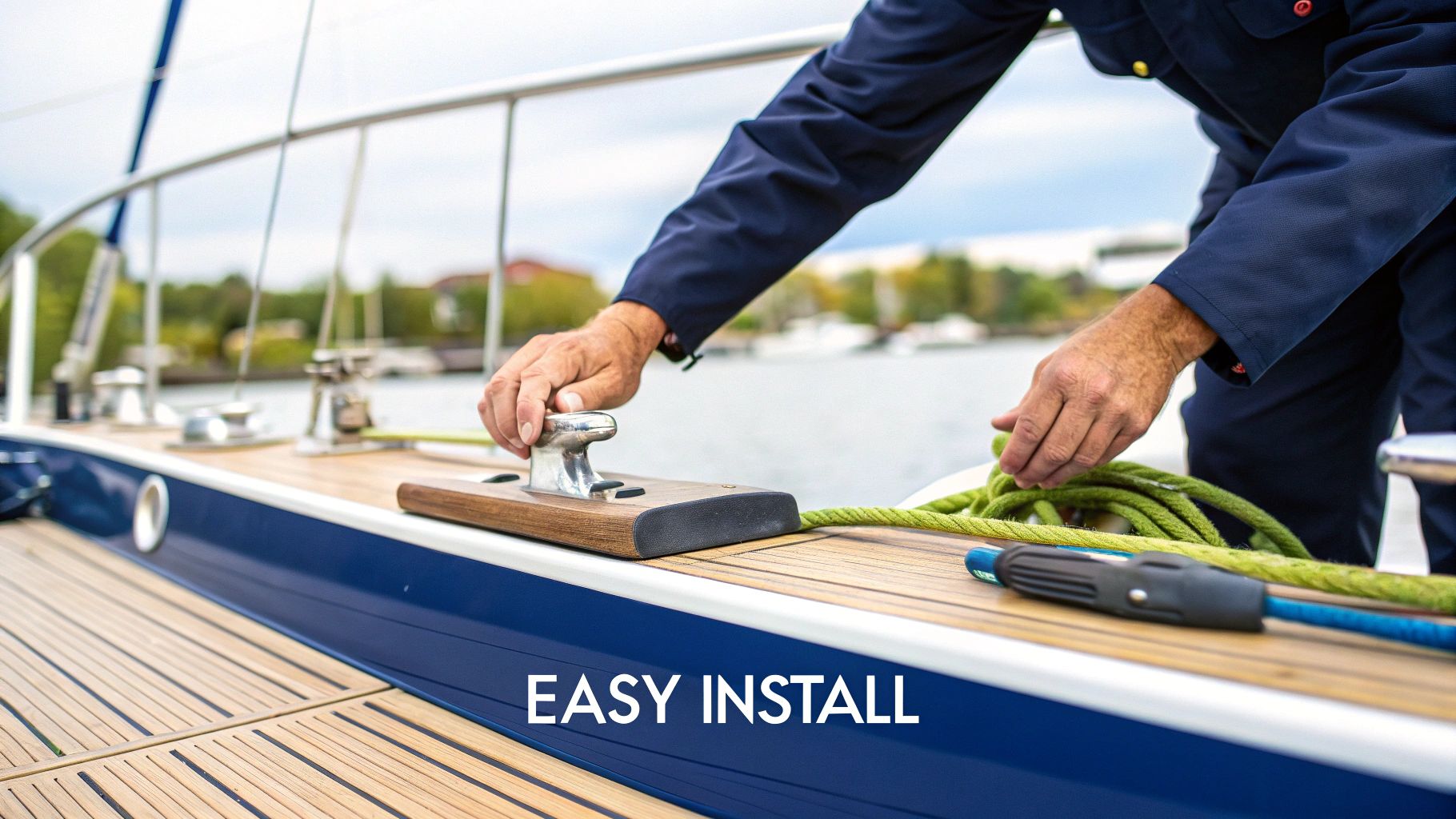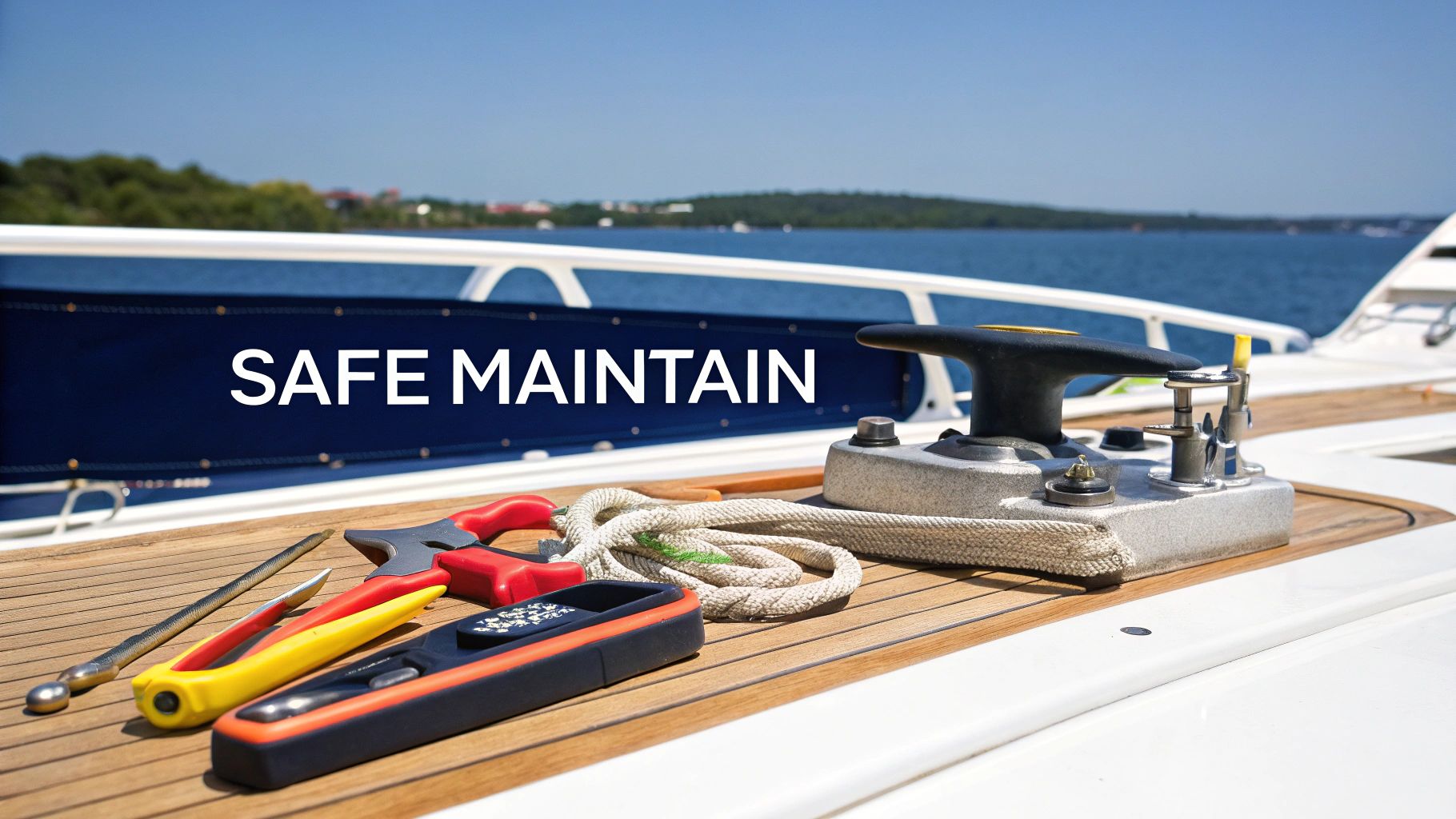The Crucial Role of Cleats on Your Vessel

Cleats might seem like simple pieces of hardware, but they are essential for safety and security on any boat. These metal fittings are the main connection points between your vessel and the dock, anchor, or other boats. Understanding their function and importance is crucial for every boater, from seasoned sailors to weekend enthusiasts.
Why Cleats Matter: Beyond Just Tying Up
Cleats are vital for various boating activities. They're used for mooring, docking, anchoring, and even towing. They also provide essential tie-off points for fenders, protecting your boat and others from damage.
Imagine trying to dock in a busy marina on a windy day without secure cleats. The potential for damage is significant.
A Look Back: The Evolution of Cleats
The concept of cleats has a long history, going back centuries. Lashed-lug boats used raised lugs, similar to cleats, for fastening hull components with natural fibers. These lugs were vital for boat construction and maritime expansion across Southeast Asia, Melanesia, and Polynesia.
The oldest known example, the Pontian boat, dates back to 260-430 CE. This history highlights the enduring need for secure fastening points on boats.
Cleat Failure: A Real-World Danger
Improperly installed or poorly maintained cleats can cause serious issues. A cleat failure under pressure could lead to a boat drifting from its mooring, colliding with other vessels, or even sinking.
This emphasizes the need to choose the right cleats for your boat, install them correctly, and keep up with regular maintenance. Even a small problem, like a loose fastener, can compromise the whole system.
Ensuring Security: Best Practices for Cleat Use
To maximize cleat effectiveness and safety, follow these key tips:
- Choose cleats appropriate for your boat's size and intended use. A larger vessel needs stronger cleats than a smaller one.
- Install cleats correctly with proper backing plates and fasteners. This distributes the load and prevents the cleats from pulling out of the deck.
- Regularly inspect cleats for signs of wear and tear. Replace any damaged or corroded cleats right away.
- Practice safe line handling techniques. Use appropriate knots and ensure lines are fastened securely.
By understanding the critical role cleats play and following these best practices, you can significantly improve your safety and enjoy peace of mind out on the water.
Selecting the Perfect Cleat for Your Boating Needs

Choosing the right boat cleat is more complicated than it seems. Just like different knots have different uses, cleats come in various designs, each with specific applications. The wrong cleat can make securing your boat difficult, cause potential damage, and even create safety hazards. Understanding cleat types is crucial for any boater.
Different Cleat Designs for Different Needs
The most common cleat types are horn cleats, cam cleats, and jam cleats. Each has pros and cons. Horn cleats are the traditional, reliable option, known for their simplicity and strength. They're great for general line securing, but can be tricky to tie off quickly. Cam cleats are best for frequent adjustments and quick release, making them popular for sails and adjustable lines. Imagine easily adjusting your sail trim mid-sail – that's the convenience of a cam cleat. Finally, jam cleats offer a very secure grip and are often used on smaller boats or when quick release isn't a priority. The design of a boat cleat depends heavily on its intended function. Traditional horn cleats are common for securing lines due to their simplicity and effectiveness. Cam cleats use spring-loaded cams, allowing for quick adjustments and easy release. Jam cleats grip the line in a v-shaped slot. Each type suits different applications based on ease of use, release speed, and line security. These designs help manage lines efficiently in various boating conditions, keeping both the boat and crew safe. Learn more about cleats).
Material Matters: Durability and Performance
Besides the basic design, the cleat's material is key for its lifespan and how well it performs. Stainless steel is a favorite for its corrosion resistance and strength, ideal for harsh marine environments. Even within stainless steel, there are different grades. 316 stainless steel is generally preferred for its superior marine-grade properties. Aluminum and various composites offer lighter options, but may not be as durable as stainless steel. Think about your boat's typical conditions when choosing a cleat material.
Choosing the Right Cleat: Factors to Consider
Several factors influence your cleat choice. Your boat's size and type, the expected loads, and the weather conditions where you boat all matter. A larger boat requires bigger, stronger cleats. Also, consider how often you'll use the cleats and if quick release is important. For more tips on boat maintenance and equipment, check out this resource: How to Master....
The following table summarizes the key differences between common cleat types, helping you make an informed decision:
Comparison of Boat Cleat Types
| Cleat Type | Best Applications | Ease of Use | Security Level | Typical Materials | Price Range |
|---|---|---|---|---|---|
| Horn Cleat | General purpose, dock lines, anchor lines | Moderate | High | Stainless steel, aluminum, nylon | Low to Medium |
| Cam Cleat | Sails, adjustable lines, frequently adjusted lines | Easy | Medium | Aluminum, composite, stainless steel | Medium to High |
| Jam Cleat | Smaller boats, applications where quick release isn't crucial | Easy | High | Stainless steel, aluminum, nylon | Low to Medium |
This table highlights the varying strengths of each cleat type. For instance, while horn cleats offer high security, they require a bit more practice to use efficiently. Cam cleats shine in ease of use and quick adjustments, but might not be as secure as horn cleats. Jam cleats provide high security and are easy to use but are less common on larger vessels.
Cleat Selection Best Practices:
- Match the cleat to the line: Use a cleat sized for your line's diameter.
- Consider the environment: Saltwater requires corrosion-resistant materials like 316 stainless steel.
- Think about accessibility: Cleats should be easy to reach, especially in tough conditions.
- Don't skimp on quality: High-quality cleats save you trouble in the long run.
By considering these factors, you can choose the right cleat for your boat, ensuring safety and peace of mind on the water.
Installation Techniques That Won't Let You Down

Choosing the right cleat is only half the battle. Even the best cleat becomes useless if installed incorrectly. This section covers the essential techniques for ensuring your cleats are ready for anything. We'll explore load distribution, fastener selection, and proper sealing.
The Importance of Backing Plates
Backing plates are crucial. They distribute the load from the cleat across a wider area of the deck. Imagine balancing a heavy object on one finger versus your entire palm. The palm distributes the weight more effectively. Similarly, a backing plate spreads the cleat's force, preventing it from ripping out.
This is especially important with fiberglass decks, which can crack under pressure. A small bolt area (roughly 2 square inches) can become 18 square inches with a backing plate. This significantly increases strength and safety. Proper cleat installation is paramount, particularly in harsh weather.
Storms place immense stress on cleats, especially with a heavy boat. Cleat failure often stems from poor installation, like using self-tapping screws without backing plates. Through-bolting with backing plates distributes the load and reduces the risk of pulling out. This applies to other hardware, too, like handholds and stanchions. Learn more about the importance of backing plates here.
Choosing the Right Fasteners
Your fasteners are just as critical as the backing plates. The wrong screws can compromise the entire installation. Avoid self-tapping screws for high-load cleats. Instead, use marine-grade stainless steel bolts with Nylock nuts. Nylock nuts help prevent loosening from vibration.
Make sure your bolts are long enough to go completely through the deck and backing plate. This creates the strongest, most secure hold. Investing in quality fasteners ensures the long-term reliability of your cleats.
Sealing for a Watertight Fit
Water can damage your deck core, leading to expensive repairs. Sealing around the cleat prevents this. Use a marine-grade sealant designed for below-the-waterline use. This creates a reliable watertight seal.
Before sealing, clean the area thoroughly. This ensures a strong bond and prevents leaks. You can also find helpful tips here.
Installation Best Practices: A Step-by-Step Guide
Here's a quick guide for installing cleats:
- Use backing plates: Distribute the load and strengthen the deck.
- Choose marine-grade stainless steel bolts and Nylock nuts: Resist corrosion and prevent loosening.
- Seal properly: Keep water out and protect your deck.
- Pre-drill holes: Prevent cracking.
- Tighten fasteners evenly: Distribute the load properly.
- Regularly inspect and maintain: Catch problems early.
Following these steps will give you secure, reliable cleats. A properly installed cleat offers peace of mind and safety, allowing you to enjoy your time on the water.
Understanding Cleat Strength: When It Matters Most

Choosing the right type of cleat is just the first step. You also need to understand how much force your cleats can handle, especially in tough conditions like strong currents or bad weather. This means looking at the materials, design, and how well your cleats are installed.
The Science of Load Capacity: How Strong is Strong Enough?
Load capacity measures the maximum force a cleat can withstand before breaking. Different materials and designs have different load capacities. For example, stainless steel cleats are usually stronger than aluminum or nylon cleats. A four-hole design generally offers more strength than a two-hole design.
Proper installation is just as important as the cleat itself. Using the right backing plates and fasteners makes a big difference. A BoatUS Foundation study tested cleat assemblies and found load capacities ranging from 1,190 to 7,500 pounds before failure. Surprisingly, 57% of failures happened at the fasteners, not the cleat itself. This highlights the importance of strong, correctly installed fasteners for overall system integrity.
Boat Size and Expected Conditions: Choosing the Right Cleat
The right cleat for your boat depends on its size and weight, as well as the conditions you typically boat in. A larger boat in rough offshore waters needs much stronger cleats than a smaller boat used on calm inland lakes. Think about the forces on your cleats when a heavy boat pulls against its mooring during a storm.
To help you choose the right cleat, let's look at a handy table:
This table shows recommended cleat sizes and load capacities based on boat length and weight.
| Boat Length | Boat Weight | Recommended Cleat Size | Minimum Load Capacity | Recommended Fastener Type |
|---|---|---|---|---|
| Under 16ft | Under 2,000 lbs | 4" | 500 lbs | #8 Stainless Steel |
| 16-25ft | 2,000-5,000 lbs | 6" | 1,000 lbs | #10 Stainless Steel |
| 26-35ft | 5,000-10,000 lbs | 8" | 2,000 lbs | 1/4" Stainless Steel Bolt |
| Over 35ft | Over 10,000 lbs | 10"+ | 3,000+ lbs | 5/16" Stainless Steel Bolt |
As you can see, the recommended cleat size and load capacity increases with boat size and weight. Always use high-quality stainless steel fasteners for maximum strength and corrosion resistance.
Recognizing Early Warning Signs of Cleat Fatigue
Regularly inspecting your cleats can prevent bigger problems. Look for stress cracks, bending, corrosion, or loose fasteners. These small signs can indicate a weakened cleat, potentially putting you at risk. Don't ignore these warning signs.
Maintenance Protocols for Extended Lifespan
Simple maintenance can significantly extend the life of your cleats. Rinse them with fresh water to remove salt and grime. Check fasteners for tightness and replace any corroded or damaged parts right away. This proactive approach keeps your cleats reliable and safe.
Practical Inspection Techniques From the Field
While marine surveyors use special tools, you can perform basic cleat inspections yourself. Check for movement in the cleat base, which indicates loose fasteners. Also, check the cleat's shape for any signs of deformation, which suggests it may have been overloaded. These simple checks can help you spot potential problems before they become serious hazards.
Line-Handling Techniques the Pros Don't Tell You
Effective line handling is more than just tying knots. It's a skill that separates seasoned sailors from novices. It encompasses knowing how to secure lines in various conditions, selecting the appropriate line, and responding swiftly in emergencies. These are the insider tips you won't find in beginner boating guides.
Mastering the Cleat Hitch: More Than Just a Knot
The cleat hitch is the go-to knot for securing a line to a cleat. While seemingly simple, subtle nuances can greatly affect its effectiveness. For instance, with slippery or smaller lines, a full wrap around the cleat's base before crossing prevents slippage.
However, for larger lines with more friction, simply running the line around both horns and crossing without a full wrap makes releasing easier. Adapting your technique to the specific line and cleat is key. This knot is crucial for holding a boat's position and preventing drift. Learn more about the cleat hitch here.
Choosing the Right Line: Material and Diameter
Line type and diameter significantly impact cleat hitch security. Experienced boaters select lines with specific properties for different purposes. A thicker, stronger line might be needed for mooring in rough weather, while a thinner, more flexible line works well for fenders.
Matching line diameter to cleat size ensures a good grip and prevents slippage. For more on line selection and care, check out this resource: How to master....
Preventing Chafe: Protecting Your Lines
Even the toughest lines are vulnerable to chafe, the wear and tear from rubbing against rough surfaces like cleats, railings, or the hull. Smart boaters use chafe guards made of leather, canvas, or specialized materials to protect their lines. Proper placement of these guards prolongs line life and prevents unexpected breaks.
Emergency Line Handling: When Seconds Matter
Quick, decisive line handling is crucial in emergencies. Imagine needing to quickly cast off a mooring line in a sudden squall, or secure a tow line in heavy seas. Practicing these maneuvers in calm conditions builds muscle memory for instinctive reactions under pressure.
Advanced Techniques: Beyond the Basics
Beyond the cleat hitch, seasoned boaters use several other knots and techniques:
- Round Turn and Two Half Hitches: Ideal for securing a line to a piling or ring.
- Bowline: Creates a strong, non-slipping, non-jamming loop.
- Spring Lines: Used to control fore and aft movement while docked.
These techniques provide precise vessel control in diverse situations, improving both safety and efficiency on the water.
Elevating Your Vessel: Maintenance and Strategic Upgrades
Regular upkeep of your boat cleats is just as important as choosing the right type. This goes beyond simple checks. It involves understanding how different materials age and how upgrades can boost both safety and functionality. Smart maintenance combined with strategic upgrades protects your investment and improves your boating experience.
Proven Maintenance Protocols From the Pros
Marine professionals stress the importance of regular cleat maintenance. Rinsing cleats with fresh water after every use, especially in saltwater, removes corrosive salt and grime. Think of it like washing your car: regular cleaning prevents long-term damage. This simple step can drastically extend the life of your cleats.
Regular inspections are also vital. Check for loose fasteners, signs of corrosion, and any damage like cracks or bending. Similar to a car mechanic checking your vehicle, you should inspect your cleats for any weaknesses. Catching problems early prevents small issues from turning into big headaches.
Upgrading Your Cleats: When and Why
Even with diligent maintenance, sometimes an upgrade is necessary. Consider upgrading if your cleats show significant wear and tear, if you're changing your boating activities (like moving to rougher waters), or if you want to improve your boat’s performance.
For instance, switching from standard stainless steel cleats to marine-grade 316 stainless steel cleats offers much better corrosion resistance. This is particularly helpful for boats frequently in saltwater. This upgrade provides long-term protection and peace of mind.
Strategic Upgrades: Improving Functionality and Aesthetics
Cleat upgrades aren’t always about replacing with the same type. Pop-up cleats, for example, make your deck look better by disappearing when not in use. These sleek cleats add a modern touch while remaining fully functional. For boaters focused on performance, specialized cleats designed for high-load situations or with quick-release features can greatly improve handling and efficiency.
Choosing Quality Manufacturers and Understanding Warranties
When choosing new cleats or upgrades, look for reputable manufacturers known for quality. Don't be tempted by cheap knock-offs that may not last in harsh marine conditions. Like any important purchase, research manufacturers and their track records.
Understanding warranty details is also important. A solid warranty protects you against defects, giving you peace of mind. Knowing the terms of your warranty ensures you're covered if any problems arise.
Budgeting for Cleat Upgrades: A Practical Approach
Cleat upgrades range in price. When planning upgrades, set priorities based on your needs and budget. Focus on the cleats that get the most use or are essential for safety. You can also spread upgrades out over time to manage costs. Just like home improvements, prioritize essential upgrades and plan others for when you have the funds.
By following these maintenance and upgrade tips, you can keep your cleats in top shape, providing safety and security for years to come.
Upgrade your fueling experience with added safety and ease. Avoid spills and gain peace of mind with CLiX Fueling Solutions. Learn more and order yours today!











